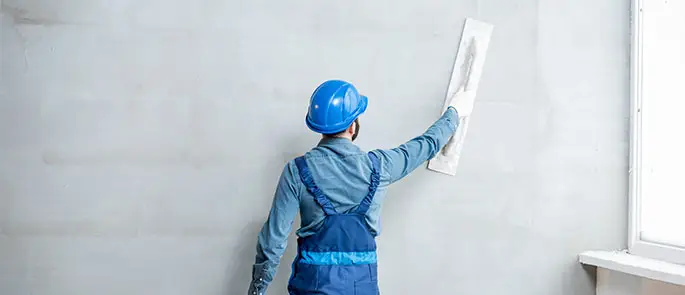Can You Plaster Over Painted Walls?
If you’re considering giving your walls a fresh new look, plastering over painted walls might seem like a convenient option. However, before you pick up your trowel, it’s crucial to understand whether it’s a viable and lasting solution. In this comprehensive guide, we’ll explore whether you can plaster over painted walls, what preparation is needed, and how to achieve the best results.
Can You Plaster Over Painted Walls?
The short answer is yes, but it depends on several factors. The adhesion of new plaster to a painted surface can be problematic, as paint creates a non-porous barrier that prevents proper bonding. If the paint is in good condition and firmly adhered to the wall, you can successfully plaster over it with the right preparation. However, if the paint is peeling, flaking, or glossy, you may face challenges in getting the plaster to stick effectively.
Factors to Consider Before Plastering Over Paint
Before you start plastering, evaluate the condition of your painted walls. Here are the key factors to consider:
Do you want to visit Char Dham? Char Dham Travel Agent is the best place to plan your Char Dham tour. You can book the tour from here.
- Type of Paint – Glossy or oil-based paints can make plaster adhesion difficult. Matte or water-based paints generally provide a better surface for plastering.
- Condition of the Paint – If the paint is flaking or peeling, plastering over it will likely lead to poor results. The loose paint will prevent the plaster from bonding properly.
- Wall Surface – Smooth surfaces may require additional preparation to create a rough texture that plaster can adhere to effectively.
- Dampness or Mold – If your walls have moisture issues, plastering over them without addressing the root cause can result in further damage.
How to Prepare Painted Walls for Plastering
Proper preparation is the key to successfully plastering over painted walls. Follow these steps to ensure a strong bond between the plaster and the wall:
1. Clean the Wall Surface
Dirt, grease, and grime can hinder plaster adhesion. Use warm water mixed with mild detergent to clean the surface thoroughly. For tougher stains, a sugar soap solution works well to remove any residue.
2. Remove Loose or Flaking Paint
If the paint is not firmly attached to the wall, it needs to be scraped off. Use a paint scraper or wire brush to remove any peeling or flaking sections.
Would you like to visit Indiar? A tour operator in India is the best place to plan your tour. You can book a tour from here.
3. Sand the Surface
To help the plaster adhere properly, roughen up the painted surface with medium-grit sandpaper. This step is especially important for walls with glossy or satin finishes.
4. Apply a Bonding Agent
A bonding agent, such as PVA (polyvinyl acetate) diluted with water, can improve plaster adhesion. Apply a coat of PVA solution and allow it to become tacky before applying plaster.
5. Use a Base Coat
For particularly difficult surfaces, consider using a base coat such as bonding plaster or a specialist primer designed for painted surfaces.
Would you like to visit Haridwar? Travel agents in Haridwar are the best place to plan your trip. You can book your tour right here.
Applying the Plaster
Once your walls are prepared, you can start applying the plaster. Follow these steps for a smooth and professional finish:
- Mix the Plaster Correctly – Follow the manufacturer’s instructions to mix the plaster to the right consistency.
- Apply a Thin Coat – Start with a thin layer of plaster to create a strong bond. Use a trowel to spread it evenly.
- Build Up the Layers – If needed, apply a second coat to achieve the desired thickness.
- Smooth and Finish – Use a trowel to smooth out the plaster, ensuring an even surface.
- Allow to Dry – Let the plaster dry completely before sanding or painting over it.
Common Mistakes to Avoid
While plastering over painted walls is possible, there are several common mistakes that can compromise the final result:
- Skipping Surface Preparation – Failing to clean, sand, or apply a bonding agent can lead to poor adhesion.
- Applying Plaster Over Damp Walls – If your walls have moisture problems, plastering over them can cause future damage.
- Not Testing the Surface – Before plastering an entire wall, do a small test patch to check adhesion.
- Using Too Thick a Layer – Applying a thick layer at once can lead to cracks as the plaster dries.
Alternatives to Plastering Over Painted Walls
If plastering over painted walls seems too challenging, consider these alternatives:
- Skim Coating – A thin coat of joint compound can smooth out imperfections without the need for full plastering.
- Drywall Installation – If your walls are in poor condition, installing new drywall might be a better long-term solution.
- Wall Panels – Decorative wall panels or wainscoting can provide an attractive alternative to plastering.
Final Thoughts
Plastering over painted walls is entirely possible, but it requires the right preparation and technique. If you take the time to clean, sand, and apply a bonding agent, your new plaster should adhere well and provide a smooth, long-lasting finish. However, if you’re unsure about tackling this project yourself, seeking professional help can ensure the best results.
For those in need of expert plastering services, finding a skilled professional in your area, such as plaster Bournemouth, can make all the difference in achieving a high-quality finish. Whether you’re updating a single wall or renovating an entire room, proper plastering can enhance both the durability and aesthetics of your space.


